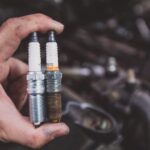Maintaining your Subaru Outback’s braking system is crucial for your safety and the safety of others on the road. Among the most important components of this system are your brake pads. Genuine Subaru brake pads are engineered specifically for your vehicle to provide optimal stopping power and safety. Understanding when to replace your Brake Pads Subaru Outback is essential for responsible vehicle ownership.
Why Choose Genuine Subaru Brake Pads for Your Outback?
Your Subaru Outback is equipped with advanced safety systems like Anti-lock Braking System (ABS) and Vehicle Dynamics Control (VDC). These systems are designed to work in perfect harmony with genuine Subaru brake pads and rotors. While aftermarket brake pads might seem like a cost-saving option, they can compromise the effectiveness of these crucial safety features. For Subaru vehicles equipped with EyeSight® Driver Assist Technology, using genuine Subaru brake pads is even more critical. EyeSight relies on precise and predictable braking performance to function correctly, and using non-genuine pads can affect its accuracy and operation. Investing in genuine Subaru brake pads ensures that your Outback maintains its intended safety performance and protects the integrity of these sophisticated systems.
Understanding When Your Subaru Outback Brake Pads Need Replacing
Brake pads work hard every time you drive. When you press the brake pedal, the pads clamp down on the rotors, creating friction that slows and stops your vehicle. This process generates significant heat and friction, causing the brake pad material to wear down over time. The lifespan of your brake pads subaru outback isn’t fixed to a specific mileage or time frame because wear depends heavily on your driving habits – factors like frequent stop-and-go traffic, aggressive braking, and driving conditions all play a role.
Because of these variable factors, regular brake inspections are paramount. It’s generally recommended to have your brakes inspected every 12,000 to 15,000 miles or every 12 to 15 months. During these inspections, a technician will measure the thickness of your brake pads to determine their remaining life.
Brake pad thickness is often categorized as follows:
- Good Pad Life (7mm–12mm): Your brake pads are in good condition.
- Requires Future Attention (4mm–6mm): Your brake pads are wearing down and will likely need replacement soon. Start planning for a brake service.
- Needs Immediate Attention (0mm–3mm): Your brake pads are dangerously thin and require immediate replacement. Driving with brake pads in this condition is unsafe and can damage your rotors.
Recognizing the Warning Signs of Worn Brake Pads on Your Subaru Outback
Beyond regular inspections, being aware of the warning signs of worn brake pads allows you to address potential issues proactively. If you experience any of the following, it’s time to have your brake pads subaru outback checked:
- Squealing or Grinding Noises: Many brake pads have built-in wear indicators that produce a squealing sound when the pads are nearing the end of their life. Grinding noises often indicate that the pads are completely worn down, and you are now experiencing metal-on-metal contact between the brake pad backing plate and the rotor. This is a serious issue that requires immediate attention as it can severely damage your rotors, leading to more costly repairs.
- Shaking or Shuddering While Braking: Vibrations or pulsations felt through the brake pedal or steering wheel during braking can indicate warped rotors or uneven wear on the brake pads.
- Spongy Brake Pedal Feel: If your brake pedal feels soft or spongy and travels further down than usual before the brakes engage effectively, it could be a sign of various brake system issues, including worn brake pads or air in the brake lines.
- Longer Stopping Distances: If you notice that it takes longer to bring your Subaru Outback to a complete stop, worn brake pads are a likely culprit. Reduced friction from worn pads diminishes braking efficiency.
- Vehicle Pulling to One Side When Braking: Uneven brake pad wear or a problem with the braking system on one side of the vehicle can cause your Outback to pull to the left or right when you apply the brakes.
- BRAKE Warning Light Illuminated: In some cases, a dashboard BRAKE warning light can indicate a problem with the braking system, which could be related to worn brake pads or low brake fluid. Consult your owner’s manual and have your brakes inspected promptly.
Maintain Your Subaru Outback’s Braking System for Peak Performance and Safety
Regular maintenance, including brake inspections and timely replacement of worn parts with genuine Subaru components, is essential for ensuring the safety and reliability of your Subaru Outback. Don’t ignore the warning signs of worn brake pads. Addressing brake issues promptly will not only keep you and your passengers safe but can also prevent more extensive and expensive repairs down the road. Schedule a brake inspection for your brake pads subaru outback today to ensure your vehicle is always ready to stop safely and effectively.
EyeSight® is a driver assist system and may not operate optimally under all driving conditions. The driver is always responsible for safe and attentive driving. System effectiveness depends on factors such as vehicle maintenance, weather, and road conditions. Refer to your Owner’s Manual for details and limitations. Remember to disable EyeSight when using a car wash.
Refer to your Warranty & Maintenance Booklet or MySubaru.com for specific service intervals for your Subaru Outback.
(Note: Image URLs need to be replaced with actual image URLs. Placeholder alt text would be created based on the actual images selected.)
